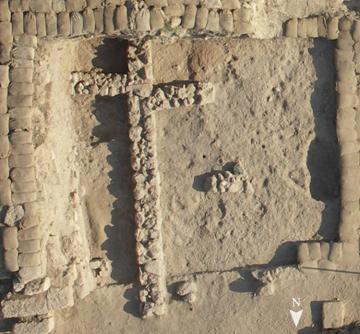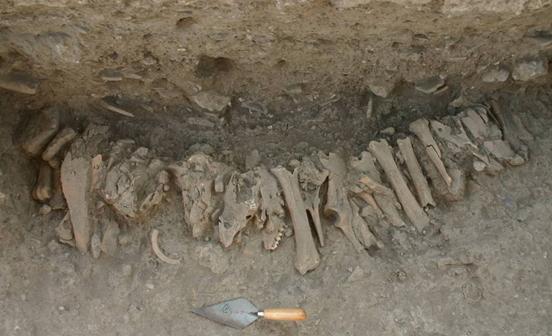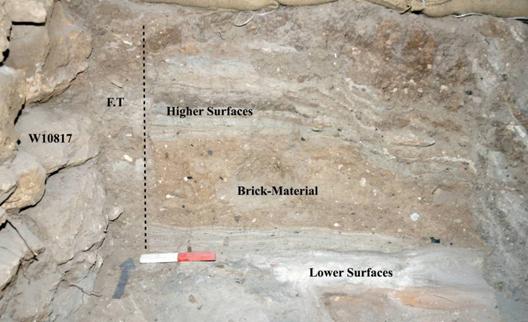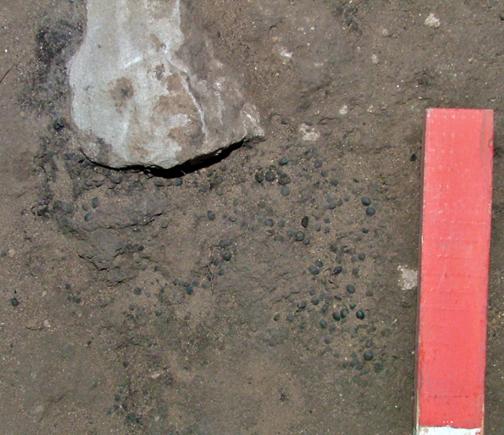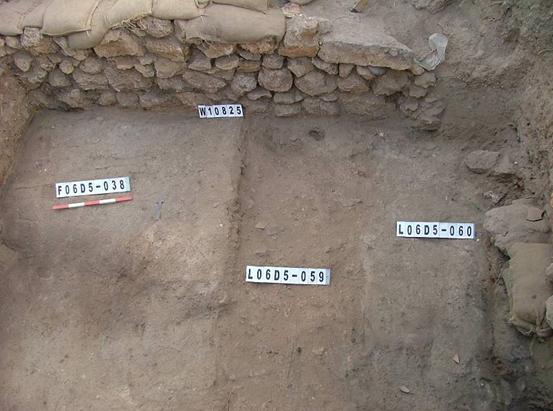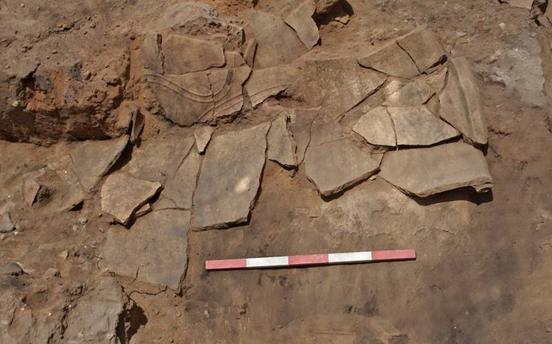Dor 2006 Preliminary Report
Area D5
Introduction
This is the new name given this year to the former 'lower D1' - a step-trench down the slope begun already in 1984 and excavated intermittently till 1996, comprising of units AT-AV/11-8. These units were always different in many respects from the rest of area D1 - being south of the 'Persian Palace' structure which dominates this area and further down the slope. The upper strata in them are rather eroded and Iron Age remains (and hopefully Bronze Age too) are consequently accessible.
Last year, we opened a probe in units AV/8-10 (Web report) to assess the feasibility of developing this into a major 'early' field. This year we started this process by adding two adjacent areas: AU-AT/10-11 (last dug in the '90's down to the level of the Murex installation - (Stern et al 2000; Stern and Sharon 1998; Stern and Sharon 1993) and AX-AW/9-11) which was begun at topsoil / slope level. Consequently, each of the sub-areas consisted of a different 'step' and excavated different periods. Actually, being on a steep slope, the westernmost unit itself consists of two different 'steps'. These will be referred-to henceforward as 'D5 West' (AX-AW/9-11, where Talia Goldman excavated Roman(?) to Hellenistic on her upper 'step' and Persian to late IrA on the lower); D5 center (or 'D5 low', the probe into Ir2a - Ir1 in units AV/10-9 which Yiftah Shalev continued to excavate this season, and D5 east (AT-AU/10-11), where Amir Haeim excavated Hellenistic and Persian period remains.
Concomitant with renaming the area, we introduced an independent stratigraphic framework, based on what we already know of the stratification of the area (although - even by the end of the season - we suspect we'll have to add [sub]phases to the scheme. For now, it is as follows:
| # | architecture | Period | comments |
| Phase 1-2 | Paved street, drain, etc | Roman | Same as D1 |
| Phase 3 | Thin 'a-telaio' walls on top of 'Persian Palace' + upper facade on the S. side of the street | Late Hellenistic | Same as D1 |
| Phase 4 | 'Persian Palace'; Murex installation | Hellenistic | |
| Phase 5 | IDegraded walls in D5 east area | Hellenistic? | A previously unattested phase |
| Phase 6 | Walls in balks of central D5; lower walls in western D5? (not yet reached in east D5); Persian pits? | Persian? | Previously phase 5? |
| Phase 7 | Massive ashlar walls in AU/8 | Late IrA? | Not encountered since the '80's |
| Phase 8 | Thick white floors (cleared in the 90's and visible in balks), apparently lower than phase 7 ashlars and sealing the 'courtyard building'. | Late IrA | |
| Phase 9 | Courtyard building | Ir2a? | Previously phase 7 |
| Phase 10 | Phytolith surfaces; cut by courtyard building | Ir1|2? | |
| Phase 11 | Burnt layer; pithos; etc. | Ir1a? | |
| ... to be continued... |
-- Top --
Roman - Hellenistic Remains - Phases 1-4
Very few of these were excavated this year. In D5 east these consisted of the removal of the phase 1-4 walls still standing in the area (but already floating) and several pits. These are tentatively attributed to phase 4 - and thus may be contemporary with the murex installation (itself consisting of two pits connected by a channel), which was excavated west of here in the 1980's.
In D5 west (upper terrace) were found several very eroded and partial phases relating to these periods. These consist of two superimposed wall systems and a complexly inter-stratified set of pits, installations and robber-trenches (Figure 16). Since at least some of these pits cut the walls and floor of the lower of the two systems (and since by contents they are mostly Hellenistic) we relegated the upper wall system to phase 1-2, the pits and the middle wall system to phase 3, and the lower wall system to 4. In that case, however, there are at least two sub-phases to 3, since some of these pits cut others. There is no real clue as to the nature of the activities in the area at any of these phases, except that one of the pits had a complete horse skull in it.
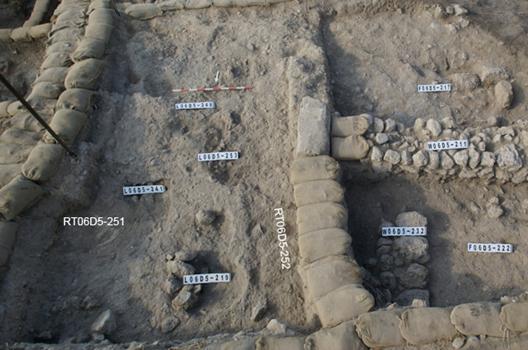
-- Top --
Phase 5 - Early Hellenistic
When the last round of excavations in D1 ended in 1998 (Stern et al 2000), a line of stones (presumed to be the top of the Persian-period fašade) was found just north of the southern street-fašade of phases 1-4, in what was to become 'D5-east'. Removal of the phase 1-4 walls, and continued excavation in east D5 revealed further walls and floors relating to this phase, making a complex of at least four rooms (Figure 17). The entire wall system, however, is very degraded - no more than a single course of the walls remains. The material on and in the floors indicates that it is still Hellenistic. Thus it is not the top of the Persian stratum, but a previously unrecognized intermediate phase.
Figs. 17, 18
The makeup of [at least one of] the phase 5 floors is rich in broken shells - mainly murex. Since this floor is well below the 'murex installation' floor of phase 4, it indicates a history of purple-industry-related activities in area D5 (see further below).
In the narrow space between W16486 and the east balk of AT/10 a curvilinear row of stones was found, reaching the bottom of wall W06D5-417. It was assumed to be part of some shallow installation associated with the phase 5 wall system. Removal of these stones, however, revealed a line of bones (Figure 18) preserving in its shape the line of stones above it. The insertion and truncation of these bones indicate intentional placement. At least four different species - horse, pig, cattle and goat/sheep were identified. It is not clear at this point what this strange feature may be, nor whether the bones are associated with the line of stones on top of them or if this is an accident of preservation (e.g. the line of stones protected the bones under them from some disturbance which cut both the rest of the installation and the bones beneath it); nor even the exact phasing of this feature. If it is not associated with the stones above it, it may well belong to a previous phase - as the bones themselves are lower than the base of W06D5-417. The bones were covered and investigation of this feature will continue next year.
-- Top --
Phases 6 - 8 Persian to Late Iron Age
Very little was excavated of these periods in D5 this season. Some of the phase 6 pits in the balks of central D5 were cleaned while trimming back the balks, and a unique figurine, depicting a Nubian(?) was found (Figure 19).

Fig. 19
In the lower 'terrace' of D5-west a set of walls probably belonging (on the basis of elevation only) to phase 6 was found, but no floor was preserved adjoining them. Deposits under these walls had clean Late-Iron-Age material. This is significant in as much as the these deposits are still above the thick white plaster floors which sealed the 'courtyard building' (see below) and which are still visible in the balk between 'central' and 'western' D5. When last excavated these were thought to be Persian floors - perhaps on account of the many [then-unrecognized] pits which riddled them. One of these late Iron Age deposits consists of crushed murex on top of broken tabun fragments - indicating that murex-related activities began in this area already in the Iron Age.
-- Top --
Phases 9 - 10 Ir2a and Ir1|2(?)
These two very different phases comprise what was previously called 'phase 7' in D1. To our shame, we found out this season that the massive stone walls framing the phytolith-surfaced courtyard and its strange installations are not associated with any of these surfaces. A clear foundation trench was observed all along W10817 - cutting both phytolith surfaces and the destruction layer below them (below). Thus the 'courtyard building' was relegated to phase D5/9 (with F06D5-012 its only true floor) while the multiple phytolith surfaces and related installations (probably representing some open-air activities) are phase 10.
Further excavation of the phytolith surfaces revealed that the installations (a - trough-like ditch leading into a bathtub-like cavity) were first dug with nearly vertical sides. As they gradually filled with organic materials their surface became sloping and shallow. To retain whatever function this installation served, a rim was constructed around it - using mudbricks and brick-material. That, too, was filled in and covered with phytolith layers, and had to be reconstructed several times (Figure 20)
Figs. 20, 21
In addition to these, another feature (a robber trench?) was observed to cut the destruction layer below the phytoliths (see below), but this one was filled-in with burnt-brick material and did not accumulate dung or other organics (Figure 21).
While the one phase 9 floor contained definite Ir2a material, the jury is still out on the scant pottery recovered between the phytolith layers. It may be Ir2a or (more likely) Ir1|2.
-- Top --
Phase 11 - An Iron Age I Destruction
The lowermost phase reached in 'lower D1' is characterized by a fiery destruction layer. This layer was reached already in two points last year (Web report) and this season gradually filled almost the entire area. Several samples of burnt sediments indicate temperatures in excess of 6000 C. Several complete or near-complete vessels were found in situ including one 'wavy-band' pithos (Figure 22) which we already began excavating last year. Below the pithos fragments was found a concentration of lentils (Figure 23) probably representing its contents.
Figs. 22, 23
While this destruction-level is definitely Iron Age I in date, it is not yet clear if it is Ir1a (i.e. relate-able to other destruction levels in other areas) or somewhat later. If the former, than it appears we are either missing the Ir1b phase here completely, or that the phytolith-accumulation phase is rather long in duration.
Area Supervisors Report (PDF file):
- Area D5
- Full version (authorized access)
- -- Table of Content -- |
- -- Top -- |
- -- Continue to Conservation --
